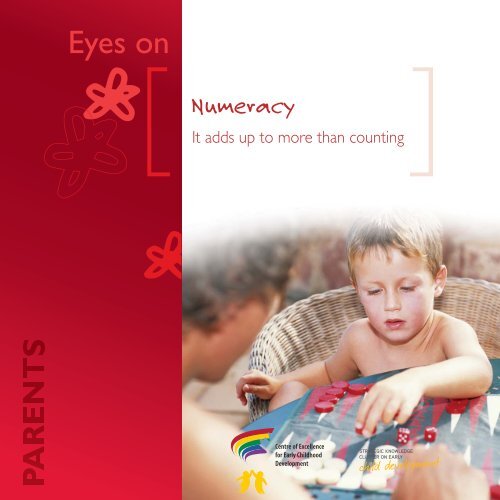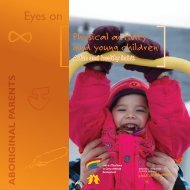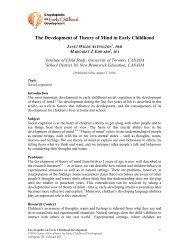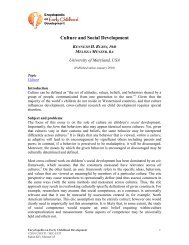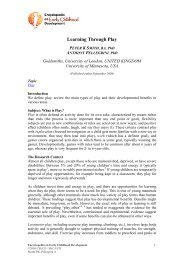Eyes on Numeracy: It adds up to more than counting - Encyclopedia ...
Eyes on Numeracy: It adds up to more than counting - Encyclopedia ...
Eyes on Numeracy: It adds up to more than counting - Encyclopedia ...
Create successful ePaper yourself
Turn your PDF publications into a flip-book with our unique Google optimized e-Paper software.
<str<strong>on</strong>g>Eyes</str<strong>on</strong>g> <strong>on</strong><br />
<strong>Numeracy</strong><br />
<strong>It</strong> <strong>adds</strong> <strong>up</strong> <strong>to</strong> <strong>more</strong> <strong>than</strong> <strong>counting</strong>
<strong>Numeracy</strong><br />
“Numerical skills often<br />
emerge during the<br />
preschool years when<br />
children are exposed<br />
<strong>to</strong> different patterns,<br />
quantity, and<br />
space in everyday<br />
activities.”<br />
© 2011 – Centre of Excellence for Early Childhood Development<br />
What do we know?<br />
■ <strong>Numeracy</strong> refers <strong>to</strong> a broad range of number-related c<strong>on</strong>cepts and math skills such as:<br />
– Knowing the names of numbers;<br />
– Seeing the difference between gro<strong>up</strong>s with a different number of objects;<br />
– Being able <strong>to</strong> count objects;<br />
– Adding and subtracting.<br />
■ <strong>Numeracy</strong> involves several developmental processes. Performance <strong>on</strong> numerical problems<br />
is likely <strong>to</strong> vary across children depending <strong>on</strong> their age and their exposure <strong>to</strong> numbers<br />
and numerical reas<strong>on</strong>ing.<br />
■ Numerical skills often emerge during the preschool years when children are exposed <strong>to</strong><br />
different patterns, quantity, and space in everyday activities.<br />
■ During the first year of life, infants become increasingly able <strong>to</strong> recognize that two sets<br />
do not possess the same number of objects. This early ability is especially evident when<br />
the number of objects is small (3 or fewer) and also when the ratio between the two<br />
sets is large (ex., a plate of 5 cookies vs. a plate of 20 cookies).<br />
■ In the <strong>to</strong>ddler years, children start <strong>to</strong> gain an understanding of what numbers mean.<br />
For example, they recognize that any set of three elements is bigger <strong>than</strong> a set of two.<br />
■ As they grow older, children learn <strong>to</strong> count objects, <strong>to</strong> understand that the last number<br />
of a count is the number of objects in a set, and <strong>to</strong> understand adding (<strong>more</strong>) and<br />
subtracting (less). These skills are fostered by the development of language.<br />
■ Language acquisiti<strong>on</strong> helps children <strong>to</strong>:<br />
– Know the name of numbers;<br />
– Develop a number sense (ex., <strong>to</strong> know what “5” is in different situati<strong>on</strong>s: 1 + 4;<br />
3 + 2; ✩✩✩✩✩);<br />
– Solve verbal problems;<br />
– Produce sums and differences in an accurate manner.<br />
■ Children’s numerical abilities during the preschool years predict later success in school.
Paying attenti<strong>on</strong> <strong>to</strong>... What can be d<strong>on</strong>e?<br />
... the way your child explores and<br />
practices his math abilities in<br />
unstructured activities.<br />
... activities that best suit your child’s age<br />
and stage of development.<br />
... materials that will help your child<br />
develop numeracy skills.<br />
... a balanced approach c<strong>on</strong>sisting of:<br />
– periods of free play, an important<br />
source of learning in children;<br />
– periods of structured guided play.<br />
... the use of number and math words<br />
when solving problems with your child.<br />
<strong>It</strong> <strong>adds</strong> <strong>up</strong> <strong>to</strong> <strong>more</strong> <strong>than</strong> <strong>counting</strong><br />
■ Create sp<strong>on</strong>taneous educati<strong>on</strong>al moments that encourage your<br />
child <strong>to</strong> think and talk about numbers. For example, ask him how<br />
many socks he should get from his sock drawer. Explain <strong>to</strong> him<br />
that he needs two by pointing <strong>on</strong>e foot at a time (“One and <strong>on</strong>e<br />
equal two”).<br />
■ Expose your child <strong>to</strong> numbers in different domains <strong>to</strong> help him<br />
recognize patterns, numbers, and shapes.<br />
– Play: dice-throwing games and board games that involve <strong>counting</strong>.<br />
– Art: drawing a number of stars.<br />
– Music: keeping a tempo of 2 or 3 beats.<br />
■ At an early age, give your child puzzles, blocks, and shapes of<br />
different colors and sizes.<br />
■ Help your child learn the labels for single-digit numbers (i.e., 0 <strong>to</strong> 9).<br />
■ Provide materials that allow your child <strong>to</strong> engage in numberrelated<br />
play <strong>on</strong> his own.<br />
■ Help your child <strong>to</strong> recognize the relati<strong>on</strong>s and patterns am<strong>on</strong>g<br />
numbers and objects. For example, ask him <strong>to</strong>:<br />
– Arrange blocks from the biggest <strong>to</strong> the smallest;<br />
– Gro<strong>up</strong> shapes that have the same colors;<br />
– Label different shapes (square, triangle, rectangle);<br />
– Count the sides of different shapes.<br />
■ When your child is playing with blocks, ask him for example “How<br />
many blocks would be left if I take away two blocks from the set of<br />
seven? You’re right! The new set c<strong>on</strong>tains five blocks now.”<br />
■ Count objects with your child aloud and emphasize the last<br />
number <strong>to</strong> show him it represents the number of items in a set<br />
(ex., “One, two, three, four, and FIVE; yes, there are FIVE cookies<br />
in the plate”).<br />
© 2011 – Centre of Excellence for Early Childhood Development
Coordina<strong>to</strong>r:<br />
Mélanie Joly<br />
Collabora<strong>to</strong>rs:<br />
Isabelle Vinet (CPEQ)<br />
Claire Gasc<strong>on</strong> Giard<br />
Jeff Bisanz<br />
Copy edi<strong>to</strong>rs:<br />
Valérie Bell<br />
Lana Crossman<br />
Graphic design:<br />
DesJardins C<strong>on</strong>cepti<strong>on</strong> Graphique inc.<br />
Informati<strong>on</strong><br />
This Key Message is a publicati<strong>on</strong> of the Centre of Excellence for Early Childhood Development<br />
(CEECD) and the Strategic Knowledge Cluster <strong>on</strong> Early Child Development (SKC-ECD).<br />
These organizati<strong>on</strong>s identify and summarize the best scientific work <strong>on</strong> early childhood<br />
development. They disseminate this knowledge <strong>to</strong> a variety of audiences in formats and<br />
languages adapted <strong>to</strong> their needs.<br />
For a <strong>more</strong> in-depth understanding of <strong>Numeracy</strong>, c<strong>on</strong>sult our synthesis and Experts’ articles <strong>on</strong><br />
this <strong>to</strong>pic in the <strong>Encyclopedia</strong> <strong>on</strong> Early Childhood Development, available free of charge at<br />
www.child-encyclopedia.com.<br />
Several funders financially s<strong>up</strong>port the CEECD and the SKC-ECD, including the Social Sciences<br />
and Humanities Research Council of Canada, Université Laval, and private foundati<strong>on</strong>s. The views<br />
expressed herein do not necessarily represent the official policies of these organizati<strong>on</strong>s.<br />
We are grateful <strong>to</strong> the F<strong>on</strong>dati<strong>on</strong> Lucie et André Chagn<strong>on</strong>, the Margaret & Wallace McCain<br />
Family Foundati<strong>on</strong> and the Alberta Centre for Child, Family and Community Research for their<br />
financial c<strong>on</strong>tributi<strong>on</strong>s <strong>to</strong> produce this Key Message.<br />
Centre of Excellence for Early Childhood Development<br />
GRIP-Université de M<strong>on</strong>tréal<br />
P.O. Box 6128, Succursale Centre-ville<br />
M<strong>on</strong>treal, Quebec H3C 3J7<br />
Teleph<strong>on</strong>e: 514.343.6111, extensi<strong>on</strong> 2541<br />
Fax: 514.343.6962<br />
E-mail: cedje-ceecd@um<strong>on</strong>treal.ca<br />
Website: www.excellence-earlychildhood.ca<br />
In this document, the masculine form is used <strong>to</strong> simplify the text. No discriminati<strong>on</strong> is intended.<br />
MC


